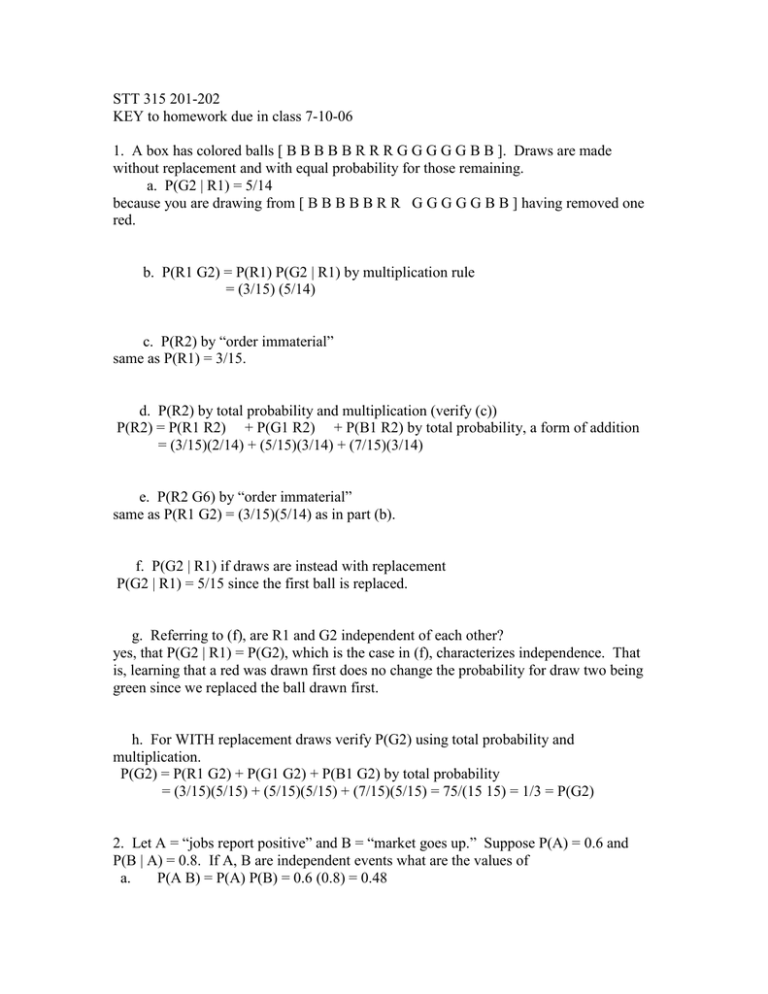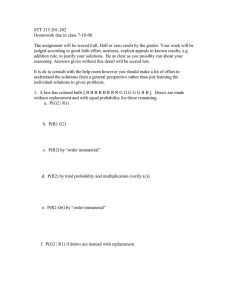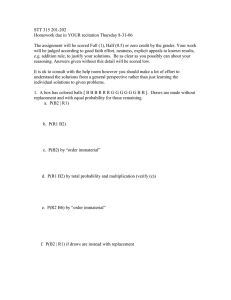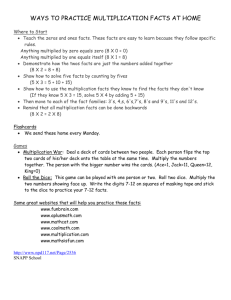STT 315 201-202 KEY to homework due in class 7-10-06
advertisement

STT 315 201-202 KEY to homework due in class 7-10-06 1. A box has colored balls [ B B B B B R R R G G G G G B B ]. Draws are made without replacement and with equal probability for those remaining. a. P(G2 | R1) = 5/14 because you are drawing from [ B B B B B R R G G G G G B B ] having removed one red. b. P(R1 G2) = P(R1) P(G2 | R1) by multiplication rule = (3/15) (5/14) c. P(R2) by “order immaterial” same as P(R1) = 3/15. d. P(R2) by total probability and multiplication (verify (c)) P(R2) = P(R1 R2) + P(G1 R2) + P(B1 R2) by total probability, a form of addition = (3/15)(2/14) + (5/15)(3/14) + (7/15)(3/14) e. P(R2 G6) by “order immaterial” same as P(R1 G2) = (3/15)(5/14) as in part (b). f. P(G2 | R1) if draws are instead with replacement P(G2 | R1) = 5/15 since the first ball is replaced. g. Referring to (f), are R1 and G2 independent of each other? yes, that P(G2 | R1) = P(G2), which is the case in (f), characterizes independence. That is, learning that a red was drawn first does no change the probability for draw two being green since we replaced the ball drawn first. h. For WITH replacement draws verify P(G2) using total probability and multiplication. P(G2) = P(R1 G2) + P(G1 G2) + P(B1 G2) by total probability = (3/15)(5/15) + (5/15)(5/15) + (7/15)(5/15) = 75/(15 15) = 1/3 = P(G2) 2. Let A = “jobs report positive” and B = “market goes up.” Suppose P(A) = 0.6 and P(B | A) = 0.8. If A, B are independent events what are the values of a. P(A B) = P(A) P(B) = 0.6 (0.8) = 0.48 b. P(A and not B) = P(A) P(not B) = 0.6 (1-0.8) = 0.12 c. P(A or B) (hint, first find P(A and B)) = by addition rule = P(A) + P(B) – P(A B) = 0.6 + 0.8 – 0.6 (0.8) 3. Red and green dice. a. P(R > G + 2) = 6/36 = 1/6 (R, G) pairs favorable to R > G + 2 are checked R\G 1 2 3 4 5 6 1 2 3 4 ck 5 ck ck 6 ck ck ck b. P(R = G + 3) = 3/36 = 1/12 since this event has the (R, G) pairs (4, 1), (5, 2), (6, 3) only. c. P(R > 4) = 2/6 = 1/3 looking only at the red die alone. (R, G) pairs favorable to R > 4 are checked R\G 1 2 3 4 5 6 1 2 3 4 5 ck ck ck ck ck ck 6 ck ck ck ck ck ck so, also in the model for two dice, P(R > 4) = 12/36 = 1/3. 4. A first ball will be selected from [ R R R G G G G ]. If the selected ball is R then remaining draws will be made without replacement from [ R G G G B]. If instead the first ball is NOT RED the remaining balls will be selected without replacement from [ R R R B G G ]. a. P(R1) = 3/7. b. P(R2 | R1) = 1/5, drawing from [ R G G G B] which R1 implies. P(R2 | G1) = 3/6, drawing from [ R R R B G G ] which G1 implies. c. P(R2) using total probability and multiplication. This will NOT necessarily be the same as P(R1) since draw one is not like the others. P(R2) = P(R1 R2) + P(G1 R2) by total probability = P(R1) P(R2 | R1) + P(G1) P(R2 | G1) by multiplication rule = (3/7) (1/5) + (4/7) (3/6) 5. A coin will be tossed 4 times. The results of these tosses are independent. a. P(H1 H2 H 3 H4) = P(H1) P(H2 | H1) P(H3 | H1 H2) P(H4 | H1 H2 H3) by multiplication rule = P(H1) P(H2) P(H3) P(H4) = 1/16 since none of the conditionings matter by independence of tosses. THE COIN HAS NO MEMORY IN OUR MODEL FOR TOSSES. b. P(H2 | H1) = P(H2) = P(H1) = 1/2. c. P(H4 | H1 H2 H3) = P(H4) = P(H1) =1/2. 6. Events A, B are independent. P(A) = 0.5, P(B) = 0.3. a. P(A B) = P(A) P(B | A) by multiplication = P(A) P(B) by independence = 0.5 (0.3) b. P(A or B) = P(A) + P(B) – P(A B) by addition = 0.5 + 0.3 – 0.5 (0.3) c. P(B | A) = P(B) = 0.3 by independence. 7. FOUR cards drawn without replacement from a deck of 52. a. P(first card is not an ace) = 1 – 4/52 = 48/52 b. P(none of the four cards is an ace) = P(1st not ace AND 2dn not ace AND 3rd not ace AND 4th not ace) = 48/52 (47/51) (46/50) (45/49) where, for example, 46/50 is the conditional probability that draw 3 is not an ace if none has been drawn before. That leaves a deck with 50 cards of which there are still four aces. c. P(all of the four cards are aces) = 4/52 (3/51) (2/50) (1/49) 8. Fill out a complete Venn for a. P(A) = 0.6, P(B) = 0.3, A independent of B region probability AB P(AB) = 0.6 (0.3) = 0.18 by independence A not B P(A) – P(AB) = 0.6 – 0.6(0.3) = 0.42 B not A P(B) – P(AB) = 0.3 – 0.6 (0.3) = 0.12 not A and not B P(not A) P(not B) = 0.4 (0.7) = 0.28 by independence The four probabilities must total 1 = 0.18 + 0.42 + 0.12 + 0.28. b. Same as (a) but instead of independence we have P(A and B) = 0.1 region AB A not B B not A not A and not B probability P(AB) = 0.1 is given P(A) – P(AB) = 0.6 – 0.1 = 0.5 P(B) – P(AB) = 0.3 – 0.1 = 0.2 1 – 0.1 – 0.5 – 0.2 = 0.2 as the four probabilities must total 1. 9. If P(A and B) = 0.3, P(A) = 0.6 what is P(B | A)? P(B | A) is defined to be P(AB) / P(A) which equals 0.3 / 0.6 = 1/2 10. Which ones are likely to be independent? a. A = “I will sleep late tomorrow” and B = “you eat fruit tomorrow” although there is some slight dependence (e.g. if the world ends both events fail to occur) as a practical matter these are independent (unrelated) events. If we learn that you eat fruit tomorrow that is not going to cause a revision in the probability that I sleep late. b. A = “left engine of aircraft fails” and B = “right engine of same aircraft fails” if failures are due to birds drawn into the engine This introduces dependence. If the left engine fails that strongly indicates that it choked on birds, increasing the chance that the right engine has failed. c. Same as (b) but failures are due to incidental breakdown and the engines are maintained in top condition The point here is that the airlines are working hard to maintain independence as well as to keep individual engines running. Each engine is being maintained so that only an unlikely chance outcome not likely to be shared by another engine will be the cause of failure. 11. Toss a pair of dice 60 times to see how many of the 60 tosses produce a total of 7. Does this come close to 60 (1/6) = 10? Most students will come fairly close to 10. 12. Explain why we work with probability models satisfying the rules obtained from classical probability. If probabilities calculated from models are to conform to counts of real world events (e.g. if the number of accident claims IS to come close to what the insurer predicts) then probabilities are linked with counts which in turn conform to the addition and multiplication rules.





